NICHOLAS CALLAN—A SCRUPULOUS LIFE OF FAITH AND SCIENCE
Published in Features, Issue 1 (January/February 2022), Volume 30By Brian Hopkins and Peter McClintock
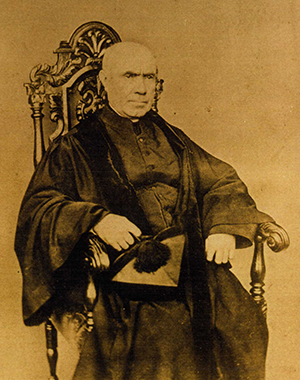
Above: Fr Nicholas Callan—born in Darver, Co. Louth, on 22 December 1799.
Darver, Co. Louth, 22 December 1799: on this date and in that village Nicholas Joseph Callan was born into a prosperous farming family with a spread of business interests, including brewing. His formal education began at the Presbyterian Dundalk Academy, followed by a stint at Navan Seminary in preparation for entering Maynooth College in 1816. Callan’s third year there proved to be a life-changing experience under the guidance of Cornelius Denvir, the college’s first chair of mathematics and natural philosophy. Denvir acquainted Callan with electricity and magnetism allied to the rigours of meticulous experimentation. There was, however, the not-insignificant step of being ordained as a Dominican priest, a landmark achieved in 1823. In 1824 Callan was attending the Sapienza University of Rome, where he was awarded a doctorate in divinity while at the same time becoming conversant with the ground-breaking work of Galvani and Volta on the transfer of electricity. By 1826 Callan had been appointed Professor of Natural Philosophy in Maynooth on the resignation of Denvir. Installed in his basement laboratory, the man from Darver was ready to begin his pioneering work on electromagnetism. Callan would have been mindful of the famous saying of the Dominican icon Albertus Magnus (St Albert the Great): ‘Science does not consist in ratifying what others say, but of searching for the causes of phenomena’.
CALLAN THE SCIENTIST
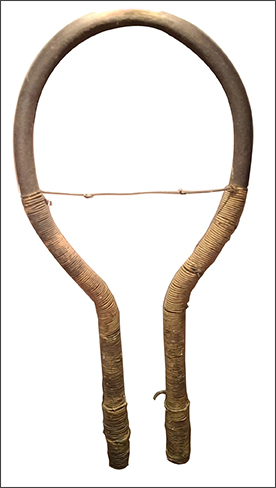
Above: Nicholas Callan’s large horseshoe electromagnet of 1836. When energised by one of his batteries, it could lift weights of up to two tonnes.
Callan was working at a time when the fundamental nature of electricity remained as yet unknown. James Clerk Maxwell’s beautiful synthesis of all electrical, magnetic and optical phenomena into a theory with just four equations lay decades in the future, and the electron would not be discovered until the end of the century. Consequently, our present picture of an electrical current as a flow of electrons was impossible. He was able, however, to build on the earlier work of several other scientists. In addition to Galvani and Volta, they included especially Michael Faraday, who discovered electromagnetic induction, and William Sturgeon, who was developing the electromagnet.
Callan realised that there seemed to be two very different manifestations of electricity. On the one hand, there were the electrostatic effects and sparks created by combing one’s hair in a dry atmosphere or rubbing amber with a cloth. He called this ‘intensity electricity’. In contrast, there was also what he called ‘quantity electricity’ from batteries, which could give rise to heating and magnetic effects but not much in the way of sparks. These days we would call them high-voltage and high-current electricity respectively, or, in a water analogy, high-pressure and high-volume flow.
No instruments were available for measuring current or voltage, so the resourceful Callan had to use indirect methods. He ‘measured’ the voltage from his early induction coils by connecting them to his students and assessing how much they jumped when electrocuted! He gauged the quality of his batteries by connecting them to electromagnets and seeing how big a weight they could lift.
Callan’s enduring vision was of electricity in the service of mankind, including electric motors and lighting. He appreciated that both forms of electricity would be needed and therefore it was important to be able to change one form into the other.
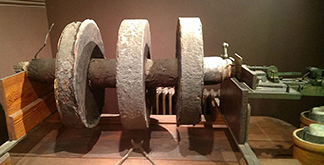
Above: Nicholas Callan’s giant induction coil of 1845. The primary coil has a relatively small number of turns of thick wire wound on the iron core. The secondary coil, wound on top of the primary, has a huge number of turns of very fine wire. It is wound in three separated sections to reduce the risk of electrical breakdown. This device could generate sparks of up to fifteen inches across the ends of the secondary coil.
The induction coil converts low-voltage, high-current electricity into the high-voltage form. It relies on a combination of Faraday’s electromagnetic induction and Sturgeon’s electromagnet and consists of an electromagnet with two coils. An iron core is wound with a primary coil made with relatively few turns of thick wire. Callan also added a secondary coil with a vastly larger number of turns of very fine wire. A relatively large current from a battery passed through the primary coil, magnetising the iron core. Lines of magnetic field from the core thread the secondary coil too, but he found that nothing interesting happened unless the current changed. When that occurred, however, Faraday’s Law came into play and the changing number of magnetic field lines induced a voltage in the secondary coil.
Callan found optimal performance when the current in the primary coil changed as fast as possible. He achieved this by rapidly switching the current on and off, many times per second. One method of doing so was based on his ‘repeater’, which used part of a grandfather clock mechanism, with wires connecting/disconnecting with vessels of mercury. He found that the step-up in voltage was related to the ratio of numbers of turns of wire in the secondary and primary coils, which is why the former had far more turns. Callan developed his induction coil, leading to enormous voltages and yielding fifteen-inch sparks between the two ends of the secondary.
The induction coil is still used today to provide the spark in a petrol-driven car engine. It was also the progenitor of the step-up transformer used today in power transmission networks because power losses are reduced with higher voltages. The step-down transformer used at the other end uses the same principle but in reverse, with more turns on the primary than on the secondary coil.
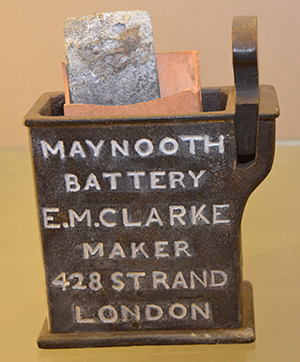
Above: A Callan-designed ‘Maynooth Battery’, as manufactured by E.M. Clarke of London, showing the outer cast-iron casing and the porous pot containing a zinc plate with a copper connector. The other connection was taken from the outer casing. The inside of the porous pot was filled with concentrated sulphuric, and the space between it and the casing with nitric acids.
Although Callan’s most important discovery was arguably the induction coil, he also achieved much else. His research was crucially dependent on the high currents obtainable from batteries. Static electricity, created by rubbing materials together, could provide high voltages but yielded negligible currents and power, so he undertook a lot of work on battery development, with great success. The batteries were chemical cells with two different kinds of metal immersed in an electrolyte (conducting liquid). Maximal currents could be obtained by connecting the cells in parallel (all the positive terminals connected together, and all the negative). Alternatively, to obtain maximal voltage, they could be connected in series (the positive of one cell to the negative of the next, and so on). He tested many battery designs, drawing on the work of Wollaston and others, but eventually arrived at his own optimal design, using a cast-iron container and zinc electrodes. Callan’s giant battery used 577 cells and was described at the time as ‘probably the world’s largest battery’. It required 30 gallons of nitric and sulphuric acids. He demonstrated its power by electrocuting a turkey and striking a five-inch arc of blinding light.
Like Faraday and Sturgeon, Callan constructed powerful electromagnets. They were in a variety of shapes and sizes but each of them consisted basically of an iron bar with wire coiled around it, carrying the current from a battery. His first experiments pre-dated the advent of insulated wire, so he had to insulate the wire himself by wrapping tape around it. His large horseshoe magnet stood almost 2m in height and could lift weights of up to two tonnes when supplied with current from a battery. In fact, he often used electromagnets to test his batteries: the larger the lifting power, the better the battery.
Consistent with his vision of electricity being useful, Callan also designed and constructed simple electric motors. Their rotors consisted of a series of iron bars mounted on the outside of a wheel. Each in turn was attracted towards an electromagnet and, just as it passed, the current was switched off so as to avoid pulling it back again. The current was then restored to attract the next bar as it approached, and so on. He hoped to use these principles to develop battery-powered locomotives for drawing trains on the railway line from Dublin to Kingstown (Dún Laoghaire), but eventually had to abandon the idea owing to difficulties in scaling up his laboratory tests, including the problem of unwieldy, spillable batteries. In perfecting his motor, Callan noticed that, at least in principle, a motor can also be made to behave as an electrical generator.
It was during the development of batteries that Callan noticed that his cast-iron cells withstood both nitric acid and the weather particularly well if first coated with an alloy of lead and tin, or platinised lead. He had discovered a new form of galvanisation, a process that he then patented.
Callan also investigated techniques for electric lighting, including lime lights and arc lights. His scheme for the former involved the electrolysis of water to its constituent hydrogen and oxygen, providing an oxy-hydrogen torch for heating a block of lime. It produced an exceptionally intense source of light that he hoped would be useful for lighthouses, but the arrangement was too explosive and dangerous for practical application.
CALLAN THE THEOLOGIAN
During the 1840s, the landscape of the Irish Catholic Church was being dramatically reshaped by Archbishop Paul Cullen, with the backing of the increasingly anti-intellectual and anti-science Pope Pius IX. In particular, Cullen, the pope’s enforcer, was determined to combat the proselytising campaign of Protestant evangelicals that was increasingly gaining traction during the years of the Great Hunger. In spirit at least, Callan was fully on board the Cullen crusade against proselytism.
Callan was enjoying the time and space to carry out his self-financed experiments, while still attending to his teaching and regular priestly duties. This lifestyle was thrown into disarray when the authorities at Maynooth informed him that he should spend more time writing about religious matters and less on his obsession with tinkering around with pieces of iron and coils of copper wire. A Jansenist-like rigorism had enveloped the college and Callan was required to ensure that his intellectual energy contributed to the battle against proselytism rather than to the outcomes of his scientific experiments.
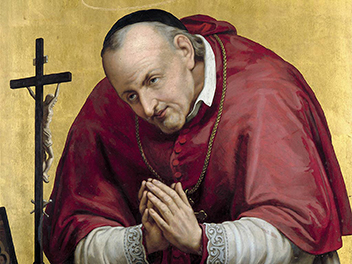
Above: St Alphonsus Liguori (1696–1787), founder of the Redemptorists in 1732 and patron saint of arthritis. He developed a system of moral theology opposed to excessive conformity to a religious doctrine, which become known as Æquiprobabilism. Under pressure from senior academics at Maynooth, Callan gave up his scientific work for about five years to focus on English translations of Liguori’s devotional treatises, among them the ‘Sermons for all the Sundays in the Year’. First published in 1851, it proved to be a best-seller among the general public in Ireland.
Callan had been captivated by the devotional writings of the moral theologian St Alphonsus Liguori and decided to embark on the demanding task of translating the copious work of the Italian into English. It was an interesting choice, as Liguori was trenchantly opposed to the threat of Jansenism and all it entailed. It is also interesting to note that Liguori was obsessed with scruples, which dictated his religious life but which at times caused him mental anguish when addressing them.
From about 1842, Callan applied his efforts unremittingly to the translation of two of Liguori’s lengthy treatises, ‘Dignity and Duties of the Priest’ (also known as Selva) and ‘Sermons for all the Sundays in the Year’. The first one functioned as a vade-mecum for fellow clergy and the second as a devotional book for the general public. Both books garnered a considerable readership and seemingly had a role in convincing John Henry Newman to convert to Catholicism. In addition to the books, Callan wrote many shorter pieces for publication in John Duffy’s popular periodicals such as the Hibernian Magazine and the Irish Catholic Magazine. Under pressure to comply with the directive to focus his writings on religious matters, Callan’s health broke down, and between 1849 and 1851 he attempted to recuperate with visits to Continental spas. On returning to Maynooth, still in poor health, he threw his energies into improving the performance of his ‘giant’ induction coil. Callan the scientist was reconstituted.
Once Callan had secured his Maynooth chair, he never assumed the mantle of an academic theologian. Rather, his theological endeavours were concerned with addressing the problems and spiritual needs of ordinary people, particularly when faced with the blandishments of ‘souperism’. He never expressed a conflict between faith and science, helped by the fact that he avoided commenting on dogmas such as papal infallibility and St Thomas Aquinas’s first-cause argument (God is the first cause of the Universe).
Callan the man
‘Darver’ in Irish means ‘the place where the oak tree grows’. The tree has several symbolic associations: strength, resilience, loyalty, courage and endurance. Such honorifics can be accorded to Callan. He showed great strength, resilience and endurance (take your pick) by continuing with his research in the face of derisive criticisms from his Maynooth colleagues and a persistent neglect of his achievements by fellow scientists (continuing well into the twentieth century). Nevertheless, he remained loyal to his Alma Mater until his death in 1864. He showed great courage in coping with the increasingly prodigious currents and voltages produced by his combination of batteries and coils, seemingly without any personal protection. And we must not forget his generosity: his sizeable inheritance enabled Callan not only to finance his research but also to make charitable donations to feed and clothe the poor of Maynooth. In fact, he made over all his salary for the relief of victims of the Great Hunger.
In both his scientific work and his religious writings, Callan was unquestionably scrupulous in disposition, often to the detriment of his health. His otherworldliness, together with a scrupulous attention to detail, bordered at times on the obsessive. Like Liguori, his behaviour might now be interpreted as something akin to an obsessive-compulsive disorder, a characteristic of many great scientists. Certainly, Callan was one of the ‘greats’ in the history of Irish science and his experiments were in advance of their time. In Ireland, his legacy was publicly acknowledged in 2000 with the issue of a stamp bearing his image. In 2006 his legacy was internationally acknowledged with an International Milestone Award by the Institute of Electrical and Electronics Engineers.
Brian Hopkins is Emeritus Professor of Psychology at Lancaster University; Peter McClintock is Emeritus Professor of Physics at Lancaster University.
Further reading
M.T. Casey, ‘Nicholas Callan—priest, professor and scientist’, Physics Education 17 (1965).
C. Mollan & J. Upton, The scientific apparatus of Nicholas Callan and other historic instruments (Maynooth, 1994).
D. O’Leary, Irish Catholicism and science: from ‘Godless colleges’ to the Celtic Tiger (Cork, 2012).
















